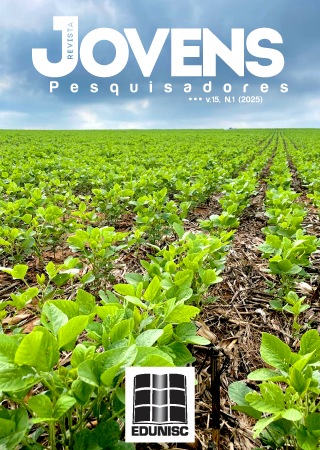CARDIORESPIRATORY FITNESS AND ITS RELATIONSHIP WITH ANTHROPOMETRIC AND BIOCHEMICAL PARAMETERS IN RURAL WORKERS
DOI:
https://doi.org/10.17058/rjp.v15i1.20323Keywords:
Cardiorespiratory Fitness, Anthropometry, Biomarkers, Rural HealthAbstract
The health of the rural population has shown an increase in obesity rates, metabolic disorders, and the presence of non-communicable diseases and health conditions. Additionally, there is limited access to healthcare services. Thus, the objective of this study was to correlate cardiorespiratory fitness (CRF) with biochemical and anthropometric variables in rural workers. This was a descriptive and correlational study involving 76 rural workers. Data collection included CRF assessment, obtained through cardiopulmonary exercise testing; anthropometric variables, measured via bioelectrical impedance analysis, including skeletal muscle mass (SMM), body mass index (BMI), body fat percentage (BF%), waist-to-hip ratio (WHR), visceral fat area (VFA), and lower limb lean mass (LLLM) for both right and left sides. Biochemical variables, analyzed through blood samples, included glucose (GLU), total cholesterol (TC), and triglycerides (TG). Data were analyzed using the Statistical Package for the Social Sciences (SPSS), applying the Shapiro-Wilk test for normality and Pearson and Spearman correlation tests to assess variable relationships. The results indicated weak to moderate correlations between CRF and biochemical variables: GLU (r= -0.226), TC (r= -0.323), and TG (r= -0.237); as well as anthropometric variables such as BMI (r= -0.231), BF% (r= -0.338), WHR (r= -0.243), VFA (r= -0.252), and positive correlations with SMM (r= 0.245), right LLLM (r= 0.236), and left LLLM (r= 0.244). CRF was associated with biochemical and anthropometric variables, suggesting that rural workers with higher CRF levels exhibited better metabolic health and body composition, particularly regarding body fat and skeletal muscle mass.
Downloads
References
CARDOSO, L. S. et al. Riscos ocupacionais no trabalho agrícola e a negociação para a saúde do trabalhador rural. Revista de Enfermagem da UFSM, v. 11, p. e43, 25 maio 2021.
CATTAFESTA, M. et al. Prevalence and determinants of obesity and abdominal obesity among rural workers in Southeastern Brazil. PLOS ONE, v. 17, n. 7, p. e0270233, 7 jul. 2022.
FONTOURA-JUNIOR, E. E.; GUIMARÃES, L. A. M. Saúde, trabalho e doença do peão pantaneiro: uma revisão integrativa. Revista Brasileira de Medicina do Trabalho, v. 17, n. 3, p. 402–414, 2019.
FONTOURA-JUNIOR, E. E. et al. Work-related accidents, musculoskeletal pain, and health-related quality of life among Pantanal farm workers in Brazil and ganaderos in Mexico. Revista Brasileira de Medicina do Trabalho, v. 20, n. 02, p. 287–297, 1 jan. 2022.
FRANCO, C. M.; LIMA, J. G.; GIOVANELLA, L. Atenção primária à saúde em áreas rurais: acesso, organização e força de trabalho em saúde em revisão integrativa de literatura. Cadernos de Saúde Pública, v. 37, n. 7, 2021.
HAIDAR, A.; HORWICH, T. B. Obesity, Cardiorespiratory Fitness, and Cardiovascular Disease. Current Cardiology Reports, 13 out. 2023.
HURTADO, S. L. B. et al. Políticas de saúde do trabalhador no Brasil: contradições históricas e possibilidades de desenvolvimento. Ciência & Saúde Coletiva, v. 27, p. 3091–3102, 22 jul. 2022.
JENSEN, L. et al. Rural Population Health and Aging: Toward a Multilevel and Multidimensional Research Agenda for the 2020s. American Journal of Public Health, v. 110, n. 9, p. 1328–1331, set. 2020.
LEE, J.; ZHANG, X. Is there really a proportional relationship between VO2max and body weight? A review article. PLOS ONE, v. 16, n. 12, p. e0261519, 21 dez. 2021.
MAGANTY, A. et al. Barriers to rural health care from the provider perspective. Disponível em: <https://www.rrh.org.au/journal/article/7769>.
MARTINS-SILVA, T. et al. Prevalências de obesidade em zonas rurais e urbanas no Brasil: Pesquisa Nacional de Saúde, 2013. Revista Brasileira de Epidemiologia, v. 22, 2019.
MATOS, A. C. G. et al. Composição corporal e capacidade cardiorrespiratória em praticantes de corrida de rua. Cuerpo, Cultura y Movimiento, v. 11, n. 2, p. 166–183, 1 jul. 2021.
MOREIRA, J. P. DE L. et al. A saúde dos trabalhadores da atividade rural no Brasil. Cadernos de Saúde Pública, v. 31, n. 8, 2015.
NIEMAN, David C. Exercício e saúde: teste e prescrição de exercícios. 6. ed. Barueri: Manole, 2011.
O’DONOGHUE, G. et al. What exercise prescription is optimal to improve body composition and cardiorespiratory fitness in adults living with obesity? A network meta-analysis. Obesity Reviews, v. 22, n. 2, 8 set. 2020.
OKOBI, O. E. et al. The Burden of Obesity in the Rural Adult Population of America. Cureus, v. 13, n. 6, 20 jun. 2021.
PELEGRINE, A. et al. Aptidão cardiorrespiratória em adolescentes. Revista Andaluza de Medicina del Deporte, v. 10, n. 3, p. 152 – 157, 2017.
POHL, H. H. et al. Indicadores antropométricos e fatores de risco cardiovascular em trabalhadores rurais. Revista Brasileira de Medicina do Esporte, v. 24, n. 1, p. 64-68, 2018.
POHL, H. H. et al. Saúde do Trabalhador e estilo de vida: uma visão multisetorial da aptidão física. FIEP Bulletin, v. 80, p. 808–812, 2010.
SANTOS et al. Parâmetros bioquímicos e antropométricos de trabalhadores rurais: estudo de novas ferramentas analíticas com supervisão de técnicas padrão. RBONE - Revista Brasileira de Obesidade, Nutrição e Emagrecimento, v. 13, n. 79, p. 478–487, 2019.
SILVA, M. Correlação de aptidão cardiorrespiratória com Índice de Massa Corporal, perfil lipídico e parâmetros sanguíneos de militares do Exército Brasileiro: um estudo transversal. Revista de Educação Física / Journal of Physical Education, v. 91, n. 1, p. 16–25, 1 set. 2022.
Downloads
Published
Issue
Section
License
A submissão de originais para este periódico implica na transferência, pelos autores, dos direitos de publicação impressa e digital. Os direitos autorais para os artigos publicados são do autor, com direitos do periódico sobre a primeira publicação. Os autores somente poderão utilizar os mesmos resultados em outras publicações indicando claramente este periódico como o meio da publicação original. Em virtude de sermos um periódico de acesso aberto, permite-se o uso gratuito dos artigos em aplicações educacionais e científicas desde que citada a fonte conforme a licença CC-BY da Creative Commons. Creative Commons Atribuição 4.0 Internacional.
Creative Commons Atribuição 4.0 Internacional.


